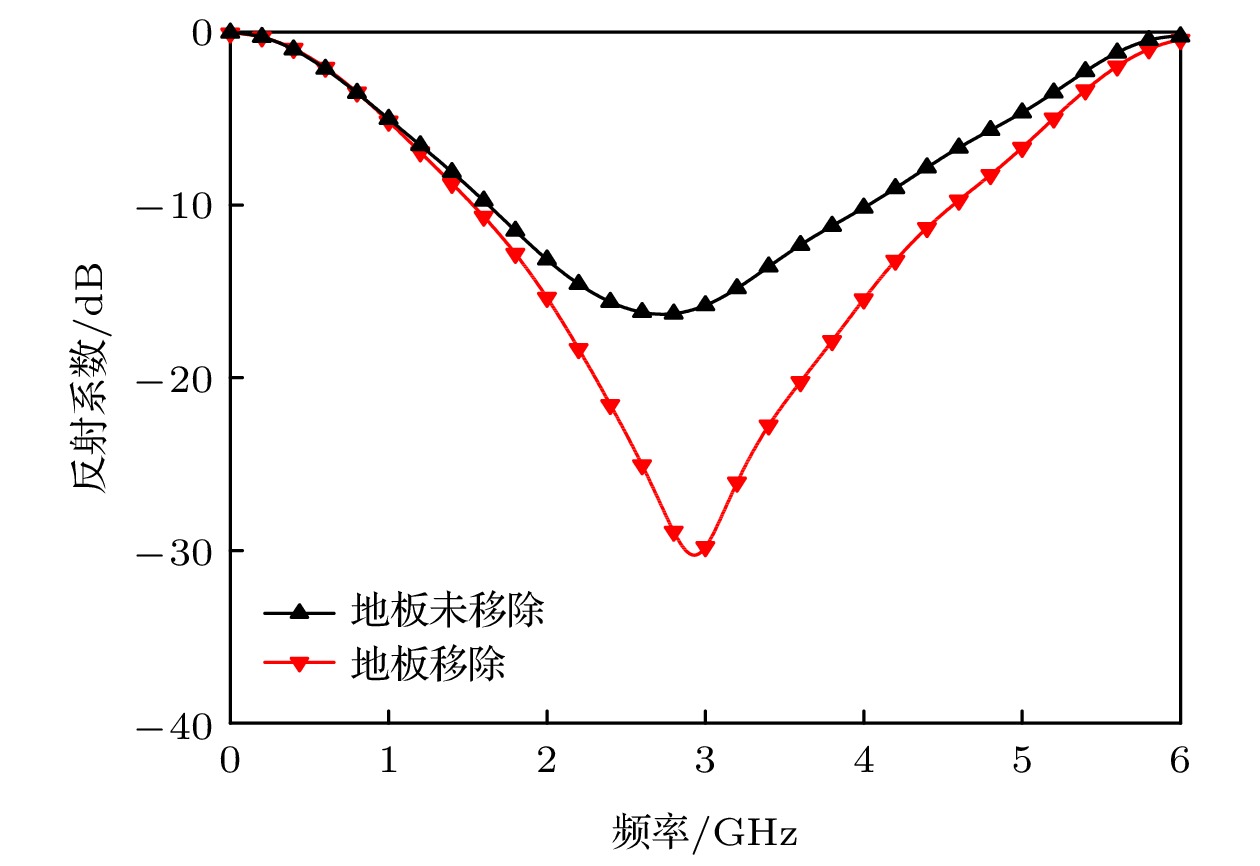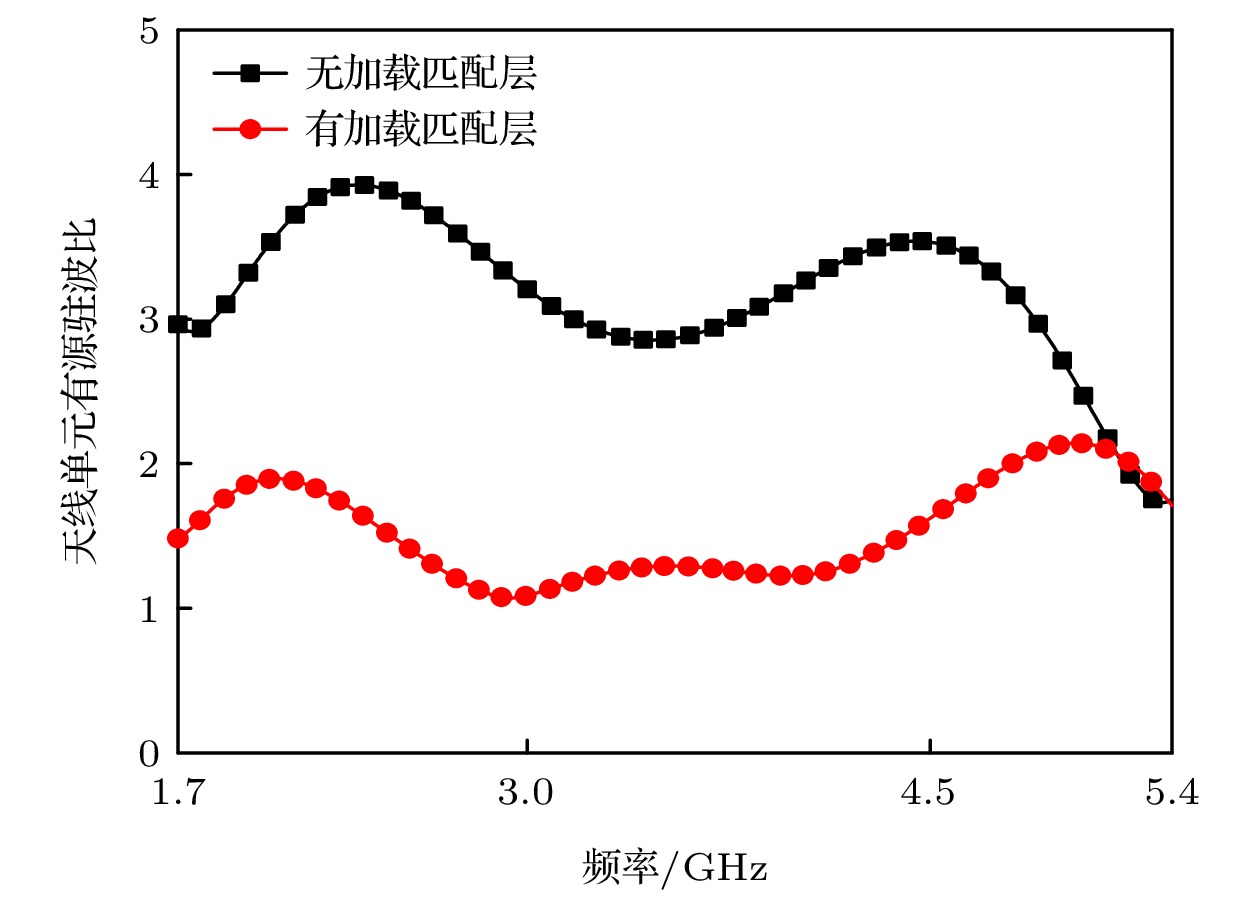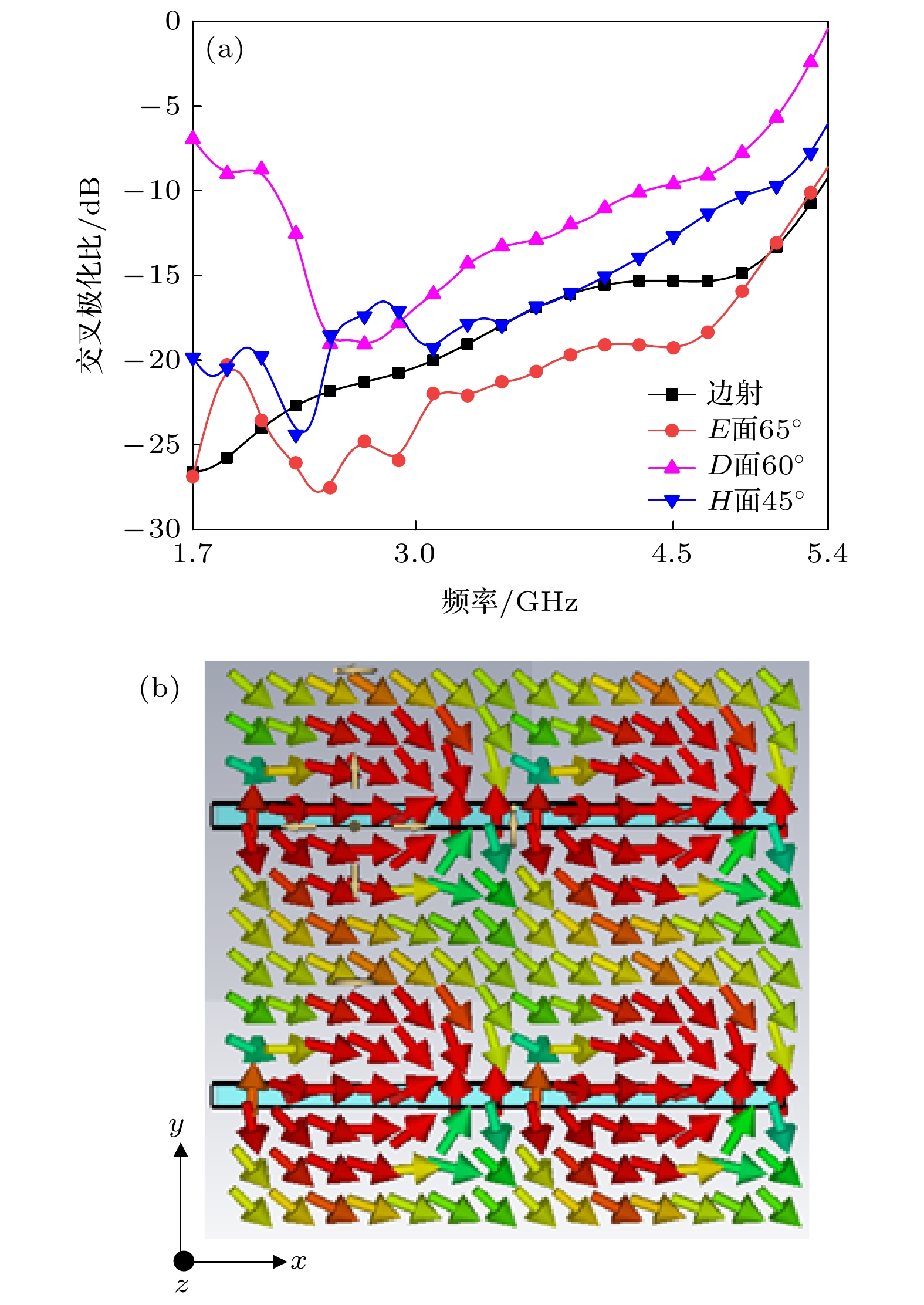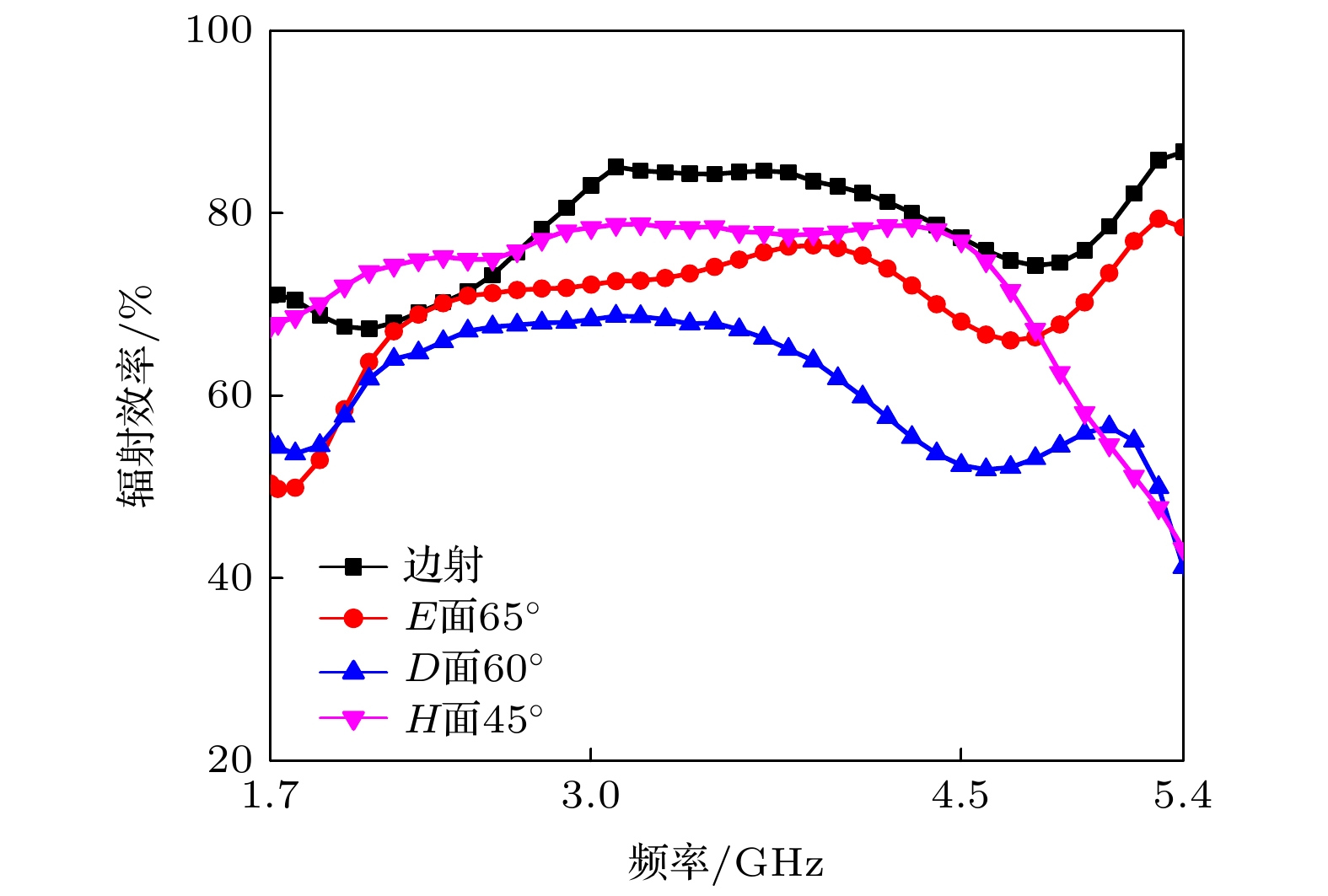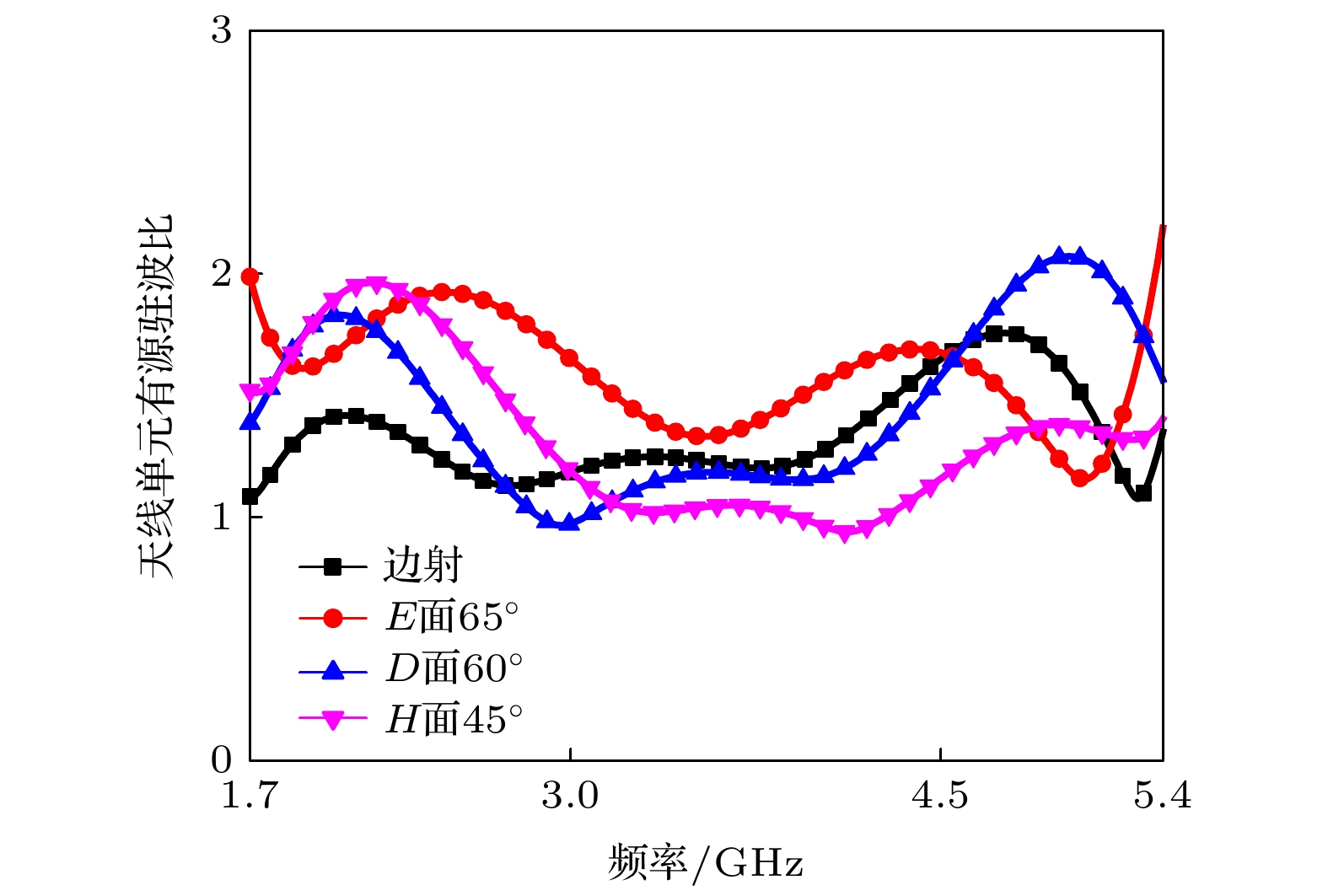-
电磁波的辐射功率对其传输距离起着决定性作用. 传统上, 可以通过增大辐射口径或增加天线单元输入功率来提升电磁波的辐射功率. 但辐射口径由于受装配空间限制而无法持续增大, 天线单元输入功率的增大也因信号源功率提升困难而难以实现. 因此, 在有限口径下, 如何提升电磁波的辐射功率成了迫切需要解决的问题. 通过在有限口径下布置更多单元进行功率合成、改善单元的阻抗匹配和减小损耗以增加天线阵的辐射效率均可提升有限口径辐射功率. 基于此, 本文设计了一个可用于提升有限口径辐射功率的紧耦合相控阵天线, 一方面采用高介电常数的介质基板使阵列小型化, 同时使用紧凑型巴伦进行馈电, 从而天线单元具有很小的尺寸, 最终天线单元周期为0.144λhigh × 0.144λhigh (λhigh为自由空间中最高工作频率对应的波长); 另一方面通过改善巴伦和天线阵的阻抗匹配, 使用频率选择表面匹配层改善天线阵和自由空间的阻抗匹配, 以及使用低损耗的介质基板, 从而提升天线阵的效率. 仿真和测试结果表明, 在1.7—5.4 GHz内天线阵具有宽角扫描性能并且保持高辐射效率. 经过对比分析, 本文设计的天线阵能够提高有限口径的辐射功率.Radiation power of an electromagnetic wave plays a decisive role in its transmission distance. Traditionally, the radiation power can be improved by expanding the radiation aperture size of the antenna array or increasing input power of the unit cell. However, the radiation aperture size is always restricted by assembly space. The input power improvement of the unit cell is always limited by the signal source. It is difficult to improve radiation power on a finite radiation aperture. However, the radiation power on a finite radiation aperture is related closely to the number of antenna elements and the radiation efficiency of the antenna array. It is useful to arrange more elements and improve radiation efficiency of the antenna array to improve the radiation power on a finite radiation aperture. Wideband wide-angle scanning phased array is able to make full use of a finite radiation aperture. The wide-angle scanning properties make it possible for the radiated power to cover a wide area. In this paper, a compact wideband wide-angle scanning tightly coupled dipole array (TCDA) is proposed. A high permittivity substrate and compact wideband balun are used for miniaturizing the antenna array. The period of the unit cell is only 0.144λhigh × 0.144λhigh (λhigh is the wavelength at the highest operation frequency in free space). Parameters of the balun are optimized to improve impedance matching between the balun and the antenna array. Two bilateral frequency selective surfaces (FSSs) are used to replace traditional dielectric superstrate to improve the impedance matching between the antenna array and free space. A low-loss dielectric substrate is used to reduce dielectric loss of the antenna array. In these ways, the radiation efficiency is greatly improved. The simulation results show that the proposed antenna array operates at 1.7–5.4 GHz (3.2:1) while scanning up to 65° in the E plane, 45° in the H plane and 60° in the D plane with following a rigorous impedance matching criterion (active VSWR < 2). A 16 × 16 prototype array is fabricated and measured. Good agreement is achieved between the simulation results and the measurement results. Compared with the designs in the literature, the proposed antenna array has an excellent performance in radiation power on a finite radiation aperture.
-
Keywords:
- radiated power /
- radiation aperture /
- phased array antennas /
- wideband wide-angle scanning
[1] Gold S H, Nusinovich G S 1997 Rev. Sci. Instrum. 68 3945
 Google Scholar
Google Scholar
[2] Chen Y, Zhang Y P 2005 IEEE Antennas Wirel. Propag. Lett. 53 3089
 Google Scholar
Google Scholar
[3] Choe H, Lim S 2014 IEEE Trans. Antennas Propag. 62 5497
 Google Scholar
Google Scholar
[4] Li J F, Chu Q X, Huang T W 2012 IEEE Trans. Antennas Propag. 60 482
 Google Scholar
Google Scholar
[5] 陈昭福, 黄华, 常安碧, 许州, 何琥, 雷禄容, 胡进光, 袁欢, 刘振帮 2014 物理学报 63 238402
 Google Scholar
Google Scholar
Chen Z F, Huang H, Chang A B, Xu Z, He H, Lei L R, Hu J J, Yuan H, Liu Z B 2014 Acta Phys. Sin. 63 238402
 Google Scholar
Google Scholar
[6] Munk B A 2003 Finite Antenna Arrays and FSS (USA: Wiley-IEEE Press) pp181−213
[7] Yetisir E, Ghalichechian N, Volakis J L 2016 IEEE Trans. Antennas Propag. 64 4256
 Google Scholar
Google Scholar
[8] Hu C H, Wang B Z, Gao G F, Wang R, Xiao S Q, Ding X 2020 IEEE Antennas Wirel. Propag. Lett. 20 63
[9] Zhang Y H, Yang S W, Xiao S W, Chen Y K, Qu S W, Hu J 2019 IEEE Antennas Wirel. Propag. Lett. 18 378
 Google Scholar
Google Scholar
[10] Lim T B, Zhu L 2008 Proceedings of the IEEE MTT-S International Microwave Workshop Series on Art Miniaturizing RF Microwave and Passive Components Chengdu, China, December 14−15, 2008 p153
[11] Zhu L, Bu H, Wu K 2000 IEEE MTT-S International Microwave Symposium Digest Boston, USA, June 11−16, 2000 p315
[12] Magill E G, Wheeler H A 1966 IEEE Trans. Antennas Propag. 14 49
 Google Scholar
Google Scholar
[13] Smith D R, Schultz S 2002 Phys. Rev. B 65 195104
 Google Scholar
Google Scholar
[14] Hood A Z, Karacolak T, Topsakal E 2008 IEEE Antennas Wirel. Propag. Lett. 7 656
 Google Scholar
Google Scholar
[15] Cavallo D, Syed W H, Neto A 2017 IEEE Trans. Antennas Propag. 65 1788
 Google Scholar
Google Scholar
[16] Hu C H, Wang B Z, Wang R, Xiao S Q, Ding X 2020 IEEE Trans. Antennas Propag. 68 2788
 Google Scholar
Google Scholar
[17] Moulder W F, Sertel K, Volakis J L 2013 IEEE Trans. Antennas Propag. 61 5802
 Google Scholar
Google Scholar
[18] Bah A O, Qin P Y, Ziolkowski RW, Guo Y J, Bird T S 2019 IEEE Trans. Antennas Propag. 67 2332
 Google Scholar
Google Scholar
[19] Jiang Z G, Xiao S Q, Yao Z X, Wang B Z 2020 IEEE Trans. Antennas Propag. 68 7348
 Google Scholar
Google Scholar
[20] Syed W H, Cavallo D, Shivamurthy H T, Neto A 2015 IEEE Trans. Antennas Propag. 64 543
[21] Xia R L, Qu S W, Yang S W, Chen Y K 2018 IEEE Trans. Antennas Propag. 66 1767
 Google Scholar
Google Scholar
-
表 1 按相同辐射口径换算, 不同文献中天线阵的辐射功率对比
Table 1. Comparisons of radiated power of antenna arrays in literatures on the same conversion size radiation aperture.
参考文献 工作频率/GHz 单元周期/λhigh × λhigh 扫描角度 有源驻波比 单元个数 辐射效率 辐射功率/W [16] 0.75—3.85 GHz
(5.1∶1)0.36 × 0.36 E-70°
H-60°< 3 771 95% 732 [17] 0.68—5.00 GHz
(7.35∶1)0.45 × 0.45 E-45°
H-45°< 3 493 70% 345 [18] 0.80—4.38 GHz
(5.5∶1)0.35 × 0.35 E-70°
H-55°< 3 816 87% 710 [19] 3.13—11.63 GHz
(3.7∶1)0.36 × 0.36 E-75°
H-60°< 3 771 84% 647 [20] 6.5—14.5 GHz
(2.23∶1)0.45 × 0.45 E-50°
H-50°< 2 493 95% 468 [21] 7.8—13.5 GHz
(1.7∶1)0.45 × 0.39 E-70°
H-70°< 2 569 90% 512 本文设计 1.7—5.4 GHz
(3.2∶1)0.144 × 0.144 E-65°
H-45°< 2 4822 84% 4050 -
[1] Gold S H, Nusinovich G S 1997 Rev. Sci. Instrum. 68 3945
 Google Scholar
Google Scholar
[2] Chen Y, Zhang Y P 2005 IEEE Antennas Wirel. Propag. Lett. 53 3089
 Google Scholar
Google Scholar
[3] Choe H, Lim S 2014 IEEE Trans. Antennas Propag. 62 5497
 Google Scholar
Google Scholar
[4] Li J F, Chu Q X, Huang T W 2012 IEEE Trans. Antennas Propag. 60 482
 Google Scholar
Google Scholar
[5] 陈昭福, 黄华, 常安碧, 许州, 何琥, 雷禄容, 胡进光, 袁欢, 刘振帮 2014 物理学报 63 238402
 Google Scholar
Google Scholar
Chen Z F, Huang H, Chang A B, Xu Z, He H, Lei L R, Hu J J, Yuan H, Liu Z B 2014 Acta Phys. Sin. 63 238402
 Google Scholar
Google Scholar
[6] Munk B A 2003 Finite Antenna Arrays and FSS (USA: Wiley-IEEE Press) pp181−213
[7] Yetisir E, Ghalichechian N, Volakis J L 2016 IEEE Trans. Antennas Propag. 64 4256
 Google Scholar
Google Scholar
[8] Hu C H, Wang B Z, Gao G F, Wang R, Xiao S Q, Ding X 2020 IEEE Antennas Wirel. Propag. Lett. 20 63
[9] Zhang Y H, Yang S W, Xiao S W, Chen Y K, Qu S W, Hu J 2019 IEEE Antennas Wirel. Propag. Lett. 18 378
 Google Scholar
Google Scholar
[10] Lim T B, Zhu L 2008 Proceedings of the IEEE MTT-S International Microwave Workshop Series on Art Miniaturizing RF Microwave and Passive Components Chengdu, China, December 14−15, 2008 p153
[11] Zhu L, Bu H, Wu K 2000 IEEE MTT-S International Microwave Symposium Digest Boston, USA, June 11−16, 2000 p315
[12] Magill E G, Wheeler H A 1966 IEEE Trans. Antennas Propag. 14 49
 Google Scholar
Google Scholar
[13] Smith D R, Schultz S 2002 Phys. Rev. B 65 195104
 Google Scholar
Google Scholar
[14] Hood A Z, Karacolak T, Topsakal E 2008 IEEE Antennas Wirel. Propag. Lett. 7 656
 Google Scholar
Google Scholar
[15] Cavallo D, Syed W H, Neto A 2017 IEEE Trans. Antennas Propag. 65 1788
 Google Scholar
Google Scholar
[16] Hu C H, Wang B Z, Wang R, Xiao S Q, Ding X 2020 IEEE Trans. Antennas Propag. 68 2788
 Google Scholar
Google Scholar
[17] Moulder W F, Sertel K, Volakis J L 2013 IEEE Trans. Antennas Propag. 61 5802
 Google Scholar
Google Scholar
[18] Bah A O, Qin P Y, Ziolkowski RW, Guo Y J, Bird T S 2019 IEEE Trans. Antennas Propag. 67 2332
 Google Scholar
Google Scholar
[19] Jiang Z G, Xiao S Q, Yao Z X, Wang B Z 2020 IEEE Trans. Antennas Propag. 68 7348
 Google Scholar
Google Scholar
[20] Syed W H, Cavallo D, Shivamurthy H T, Neto A 2015 IEEE Trans. Antennas Propag. 64 543
[21] Xia R L, Qu S W, Yang S W, Chen Y K 2018 IEEE Trans. Antennas Propag. 66 1767
 Google Scholar
Google Scholar
计量
- 文章访问数: 9001
- PDF下载量: 138
- 被引次数: 0














 下载:
下载:
